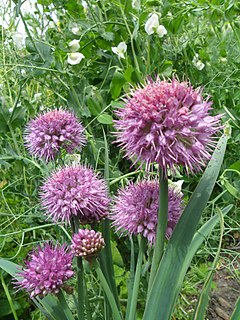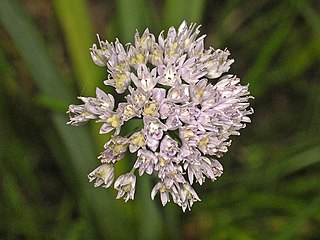| 宽苞韭 kuan bao jiu Лук широкочехольный | |
|---|---|
| Scientific classification | |
| Kingdom: | Plantae |
| Clade: | Angiosperms |
| Clade: | Monocots |
| Order: | Asparagales |
| Family: | Amaryllidaceae |
| Subfamily: | Allioideae |
| Genus: | Allium |
| Species: | A. platyspathum |
| Binomial name | |
| Allium platyspathum Schrenk ex Fisch. & C.A. Mey. | |
| Synonyms [1] | |
| |
Allium platyspathum is an Asian species of wild onion. It has been reported from Xinjiang, Afghanistan, Kazakhstan, Kyrgyzstan, Mongolia, Altay Krai, Tajikistan, Uzbekistan, and Pakistan. It grows in damp locations at elevations of 1900–3700 m. [2] [3] [4] [5]

Asia is Earth's largest and most populous continent, located primarily in the Eastern and Northern Hemispheres. It shares the continental landmass of Eurasia with the continent of Europe and the continental landmass of Afro-Eurasia with both Europe and Africa. Asia covers an area of 44,579,000 square kilometres (17,212,000 sq mi), about 30% of Earth's total land area and 8.7% of the Earth's total surface area. The continent, which has long been home to the majority of the human population, was the site of many of the first civilizations. Asia is notable for not only its overall large size and population, but also dense and large settlements, as well as vast barely populated regions. Its 4.5 billion people constitute roughly 60% of the world's population.
Wild onion can refer to

Xinjiang, officially the Xinjiang Uygur Autonomous Region (XUAR), is a provincial-level autonomous region of China in the northwest of the country. It is the largest Chinese administrative division and the eighth largest country subdivision in the world, spanning over 1.6 million km2. Xinjiang contains the disputed territory of Aksai Chin, which is administered by China and claimed by India. Xinjiang borders the countries of Mongolia, Russia, Kazakhstan, Kyrgyzstan, Tajikistan, Afghanistan, Pakistan (Gilgit-Baltistan), and India. The rugged Karakoram, Kunlun, and Tian Shan mountain ranges occupy much of Xinjiang's borders, as well as its western and southern regions. Xinjiang also borders Tibet Autonomous Region and the provinces of Gansu and Qinghai. The most well-known route of the historical Silk Road ran through the territory from the east to its northwestern border. In recent decades, abundant oil and mineral reserves have been found in Xinjiang, and it is currently China's largest natural gas-producing region.
Allium platyspathum usually produces a single egg-shaped bulb up to 20 mm in diameter. Scape is up to 100 cm tall. Leaves are flat, linear, up to 20 mm across, about the same length as the scape. Umbel is a densely packed cluster of pink or lilac flowers. [2] [6]

In botany, a scape is a long internode that forms the basal part or the whole of a peduncle. Typically it takes the form of a long, leafless flowering stem rising directly from a bulb, rhizome, or similar subterranean or underwater structure.
An umbel is an inflorescence that consists of a number of short flower stalks which spread from a common point, somewhat like umbrella ribs. The word was coined in botany in the 1590s, from Latin umbella "parasol, sunshade". The arrangement can vary from being flat topped to almost spherical. Umbels can be simple or compound. The secondary umbels of compound umbels are known as umbellules or umbellets. A small umbel is called an umbellule. The arrangement of the inflorescence in umbels is referred to as umbellate, or occasionally subumbellate.
- Varieties [1] [2]
- Allium platyspathum subsp. amblyophyllum(Kar. & Kir.) N.Friesen -- scape 40–100 cm long, flowers pink; leaves 10–20 mm wide - Xinjiang, Afghanistan, Kazakhstan, Kyrgyzstan, Mongolia, Altay Krai
- Allium platyspathum subsp. platyspathum—scape up to 25 cm long; flowers lilac, leaves less than 8 mm wide - Xinjiang, Afghanistan, Kazakhstan, Kyrgyzstan, Mongolia, Altay Krai, Tajikistan, Uzbekistan, Pakistan

Afghanistan, officially the Islamic Republic of Afghanistan, is a landlocked country located in South and Central Asia. Afghanistan is bordered by Pakistan in the south and east; Iran in the west; Turkmenistan, Uzbekistan, and Tajikistan in the north; and in the far northeast, China. Its territory covers 652,000 square kilometers (252,000 sq mi) and much of it is covered by the Hindu Kush mountain range, which experiences very cold winters. The north consists of fertile plains, whilst the south-west consists of deserts where temperatures can get very hot in summers. Kabul serves as the capital and its largest city.

Kazakhstan, officially the Republic of Kazakhstan, is the world's largest landlocked country, and the ninth largest in the world, with an area of 2,724,900 square kilometres (1,052,100 sq mi). It is a transcontinental country largely located in Asia; the most western parts are located in Europe. Kazakhstan is the dominant nation of Central Asia economically, generating 60% of the region's GDP, primarily through its oil/gas industry. It also has vast mineral resources.

Kyrgyzstan, officially the Kyrgyz Republic, and also known as Kirghizia, is a country in Central Asia. Kyrgyzstan is a landlocked country with mountainous terrain. It is bordered by Kazakhstan to the north, Uzbekistan to the west and southwest, Tajikistan to the southwest and China to the east. Its capital and largest city is Bishkek.
- formerly included [1]
Allium platyspathum var. falcatumRegel, now called Allium carolinianum Redouté

Allium carolinianum is a species of onions native to central and southern Asia. It grows in sunlit slopes at elevations of 3000–5000 m.

